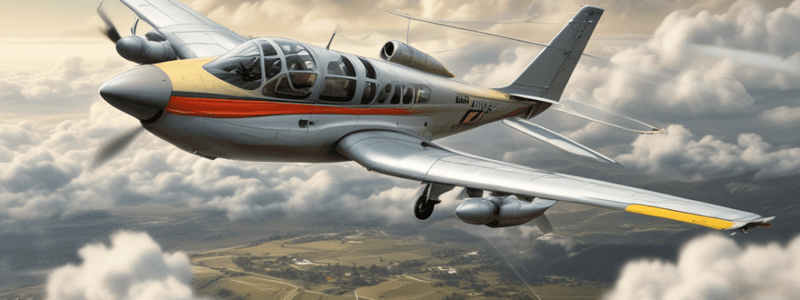Podcast
Questions and Answers
What is the primary purpose of monitoring airspeed vigilantly?
What is the primary purpose of monitoring airspeed vigilantly?
- To prevent loss of control incidents
- To practice slow flight in training conditions
- To maintain a buffer above stall speed (correct)
- To understand weight and balance of the aircraft
What is the benefit of practicing slow flight in training conditions?
What is the benefit of practicing slow flight in training conditions?
- To avoid abrupt maneuvers
- To improve airspeed monitoring skills
- To develop a feel for the aircraft's handling characteristics at low airspeeds (correct)
- To understand environmental factors affecting control
What is the consequence of making abrupt maneuvers?
What is the consequence of making abrupt maneuvers?
- Environmental factors affecting control
- Stall or excessive stress on the airframe (correct)
- Loss of airspeed
- Compromised control
How does an aircraft's weight and balance affect stall speed and handling?
How does an aircraft's weight and balance affect stall speed and handling?
What environmental factor requires careful rudder and aileron input to maintain directional control?
What environmental factor requires careful rudder and aileron input to maintain directional control?
Why is it essential for pilots to respect the limitations of their aircraft?
Why is it essential for pilots to respect the limitations of their aircraft?
What is the primary benefit of mastering techniques for low-speed flight?
What is the primary benefit of mastering techniques for low-speed flight?
Why is recurrent training important for pilots?
Why is recurrent training important for pilots?
What is the primary purpose of understanding environmental factors affecting control?
What is the primary purpose of understanding environmental factors affecting control?
Why is it important for pilots to make smooth and coordinated control inputs?
Why is it important for pilots to make smooth and coordinated control inputs?
Aircraft stall speed remains constant regardless of changes in weight and balance.
Aircraft stall speed remains constant regardless of changes in weight and balance.
A buffer above stall speed should be maintained to ensure smooth flight.
A buffer above stall speed should be maintained to ensure smooth flight.
Crosswinds do not require any special control inputs to maintain directional control.
Crosswinds do not require any special control inputs to maintain directional control.
Mastering low-speed flight techniques increases the risk of loss of control incidents.
Mastering low-speed flight techniques increases the risk of loss of control incidents.
Recurrent training is not necessary for pilots to maintain their skills.
Recurrent training is not necessary for pilots to maintain their skills.
Environmental factors do not affect control at low speeds.
Environmental factors do not affect control at low speeds.
Smooth and coordinated control inputs can cause an aircraft to stall.
Smooth and coordinated control inputs can cause an aircraft to stall.
The primary benefit of practicing slow flight is to improve takeoff and landing skills.
The primary benefit of practicing slow flight is to improve takeoff and landing skills.
Maintaining a buffer above stall speed is only necessary during takeoff and landing.
Maintaining a buffer above stall speed is only necessary during takeoff and landing.
Respecting the limitations of an aircraft only applies to high-speed flight.
Respecting the limitations of an aircraft only applies to high-speed flight.
What is the primary reason for maintaining a buffer above stall speed, and what are the consequences of failing to do so?
What is the primary reason for maintaining a buffer above stall speed, and what are the consequences of failing to do so?
How does an aircraft's weight and balance affect its handling during low-speed flight, and what are the implications for pilots?
How does an aircraft's weight and balance affect its handling during low-speed flight, and what are the implications for pilots?
What are the key elements of environmental awareness during low-speed flight, and why are they crucial for maintaining control?
What are the key elements of environmental awareness during low-speed flight, and why are they crucial for maintaining control?
What is the relationship between slow flight practice and pilot proficiency, and why is it essential for reducing the risk of loss of control incidents?
What is the relationship between slow flight practice and pilot proficiency, and why is it essential for reducing the risk of loss of control incidents?
Why is smooth and coordinated control input critical during low-speed flight, and what are the consequences of making abrupt maneuvers?
Why is smooth and coordinated control input critical during low-speed flight, and what are the consequences of making abrupt maneuvers?
How does the aircraft's performance during low-speed flight impact the pilot's ability to maintain control, and what skills must pilots develop to mitigate this risk?
How does the aircraft's performance during low-speed flight impact the pilot's ability to maintain control, and what skills must pilots develop to mitigate this risk?
What is the role of recurrent training in maintaining pilot proficiency, and why is it essential for reducing the risk of loss of control incidents?
What is the role of recurrent training in maintaining pilot proficiency, and why is it essential for reducing the risk of loss of control incidents?
How does the aircraft's center of gravity impact its stall speed, and what implications does this have for pilots?
How does the aircraft's center of gravity impact its stall speed, and what implications does this have for pilots?
What is the critical role of airspeed indicator monitoring during low-speed flight, and why is it essential for maintaining control?
What is the critical role of airspeed indicator monitoring during low-speed flight, and why is it essential for maintaining control?
Why is it essential for pilots to operate within the established flight envelope, and what are the consequences of exceeding its limits?
Why is it essential for pilots to operate within the established flight envelope, and what are the consequences of exceeding its limits?
Flashcards are hidden until you start studying
Study Notes
Mastering Aircraft Performance: Commercial Pilot Essentials
Module 3: Performance Charting and Environmental Considerations
- Focus on managing control during low-speed phases of flight, which include taxi, takeoff roll, initial climb, approach, and landing.
- Low-speed flight phases require keen control to counteract decreased aerodynamic forces, making the aircraft less responsive and narrowing the margin for error.
Region of Reversed Command
- Higher weight increases speed, bringing aircraft closer to region of reversed command, where more power is needed to fly slower.
- Gear and flap configurations can shift entry into this delicate flight situation.
- Grasping practical implications of operating in this region is vital, as misjudgment can lead to stall or overshoot on landing.
- Key strategies for navigating this region include staying aware of airspeed and power settings, practicing stall recovery procedures, and planning approaches with extra vigilance.
Low-Speed Control Challenges
- Mastering low-speed phases is crucial for ensuring safety during critical phases like approach and landing, where flight safety margin is slim.
- Factors affecting low-speed control include:
- Uneven weight distribution or heavy aircraft, which alter performance characteristics.
- Environmental factors like gusts of wind or sudden temperature changes, which can exacerbate control challenges.
Techniques for Managing Low-Speed Control
- Anticipate the aircraft's behavior and be prepared to make immediate corrections.
- Maintain optimum angle of attack using the AOA indicator, if available.
- Use trim effectively to reduce pilot workload and maintain desired airspeed and altitude.
- Understand power management, as power primarily controls airspeed and pitch controls altitude in the region of reversed command.
- Be aware of configuration and its impact on lift and drag, and deploy flaps as recommended for various phases of low-speed flight.
- Monitor airspeed vigilantly, maintaining a buffer above stall speed.
- Practice slow flight regularly to develop a feel for the aircraft's handling characteristics at low airspeeds.
- Avoid abrupt maneuvers and make smooth, coordinated control inputs.
- Understand how weight and balance affect stall speed and handling during low-speed flight.
- Be aware of environmental factors like wind gusts and turbulence, and crosswinds in particular.
Best Practices for Low-Speed Flight
- Conduct thorough pre-flight planning, accounting for environmental factors and aircraft weight and balance.
- Remain vigilant for signs of impending control issues during low-speed flight.
- Always prioritize safety and consider going around if in doubt.
- Practice and scenario-based training are essential for managing low-speed control.
Performance Charting and Environmental Considerations
- The region of reversed command is a critical aerodynamic principle where more power is required to fly slower than to fly faster, contrary to normal operations.
- This region occurs near an aircraft's stalling speed, where maintaining altitude demands an increase in engine power as speed decreases.
Aerodynamic Principles
- The power curve charts the relationship between flight speed and power required.
- At low speeds, the power curve shows that flying slower requires more power.
- Conversely, on the front side, as speed increases, less power is needed to maintain altitude.
Normal and Reversed Command
- In the normal region, adding power allows for speeding up and climbing, and reducing power leads to a descent and deceleration.
- In the reversed command region, reducing speed requires more power to maintain altitude, and loss of speed without proper power adjustment leads to an aerodynamic stall.
Factors Affecting Reversed Command
- Weight, altitude, and configuration impact flight in the region of reversed command.
- A higher weight increases the speed at which the aircraft enters the reversed command region.
- High altitude flying demands greater thrust as the air is less dense, bringing the aircraft closer to the condition of reversed command.
- Gear and flap configurations can shift the entry into this delicate flight situation.
Practical Implications
- Grasping the practical implications of operating in the region of reversed command is vital, particularly during the final approach and landing phases.
- A misjudgment in this region can lead to a stall or an overshoot on landing.
Navigating the Region of Reversed Command
- Stay keenly aware of airspeed and power settings.
- Practice and internalize stall recovery procedures.
- Plan approaches with extra vigilance, allowing for variations in configuration and environmental factors.
- Continuous education and practice in different conditions will hone the ability to swiftly react when flying close to the stall speed.
Low-Speed Flight
- Low-speed flight is characterized by increased drag, requiring greater power to maintain lift and forward speed.
- Effective management of these principles allows for smoother transition through low-speed phases.
Best Practices
- Always conduct thorough pre-flight planning, accounting for environmental factors, and aircraft weight and balance.
- Remain vigilant for signs of impending control issues during low-speed flight.
- When in doubt, go around; safety is the top priority.
Controlling Low-Speed Flight
- Techniques to manage low-speed control challenges include:
- Proper throttle management to adjust lift.
- Using flaps to increase the aircraft's lift coefficient.
- Performing trimming to stabilize the aircraft.
- Every control input must be precise and deliberate.
Managing Low-Speed Flight Effectively
- Anticipate the aircraft's behavior and be prepared to make immediate corrections.
- Maintain the optimum angle of attack.
- Use trim effectively to reduce workload and minimize the risk of an inadvertent stall.
- Understand power management, configuration awareness, and monitor airspeed vigilantly.
- Practice slow flight in training conditions to develop a feel for the aircraft's handling characteristics at low airspeeds.
- Avoid abrupt maneuvers and understand weight and balance.
- Be aware of environmental factors that affect control at low speeds.
Region of Reversed Command
- The region of reversed command is a critical aerodynamic principle where more power is required to fly slower than to fly faster, contrary to normal operations.
- It occurs near an aircraft's stalling speed, where maintaining altitude demands an increase in engine power as speed decreases.
Power Curve and Factors Influencing Region of Reversed Command
- The power curve charts the relationship between flight speed and power required.
- At low speeds, the aircraft moves up the backside of the power curve, where flying slower requires more power.
- Factors such as weight, altitude, and configuration impact the flight in the region of reversed command.
Normal and Reversed Command
- In the normal region, adding power allows the aircraft to speed up and climb, while reducing power leads to a descent and deceleration.
- In the reversed command region, reducing speed requires more power to maintain altitude, and loss of speed without proper power adjustment may lead to an aerodynamic stall.
Importance of Understanding Region of Reversed Command
- Recognizing the region of reversed command is fundamental for precision in power management and stall avoidance.
- It's crucial for safe and efficient flight operations, especially during low-speed maneuvers.
Practicing and Mastering Region of Reversed Command
- Stay aware of airspeed and power settings.
- Practice and internalize stall recovery procedures.
- Plan approaches with extra vigilance, allowing for variations in configuration and environmental factors.
- Continuous education and practice in different conditions will hone the ability to swiftly react when flying close to the stall speed.
Low-Speed Flight Phases and Control Challenges
- Low-speed flight phases include taxi, takeoff roll, initial climb, approach, and landing.
- The mastery of low-speed phases is not just about technical knowledge; it's about ensuring the safety of every passenger, crew member, and the aircraft itself.
- Control challenges arise due to decreased aerodynamic forces, making the aircraft less responsive and reducing the margin for error.
Factors Affecting Low-Speed Control
- Aircraft weight and balance: uneven weight distribution or a heavy aircraft alters performance characteristics, making control at low speeds more complex.
- Environmental factors: gusts of wind, sudden changes in temperature, or wind shear can exacerbate control challenges.
Techniques for Managing Low-Speed Control Challenges
- Proper throttle management to adjust lift.
- Using flaps to increase the aircraft's lift coefficient.
- Performing trimming to stabilize the aircraft.
- Every control input must be precise and deliberate.
Best Practices for Low-Speed Flight
- Conduct thorough pre-flight planning, accounting for environmental factors and aircraft weight and balance.
- Remain vigilant for signs of impending control issues during low-speed flight.
- When in doubt, go around, as safety is the top priority.
Additional Tips for Managing Low-Speed Control
- Monitor airspeed vigilantly, maintaining a buffer above stall speed.
- Practice slow flight in training conditions to develop a feel for the aircraft's handling characteristics at low airspeeds.
- Avoid abrupt maneuvers, making smooth and coordinated control inputs.
- Understand the impact of weight and balance on stall speed and handling during low-speed flight.
- Be aware of environmental factors that can affect control at low speeds, such as wind gusts and turbulence.
Studying That Suits You
Use AI to generate personalized quizzes and flashcards to suit your learning preferences.




